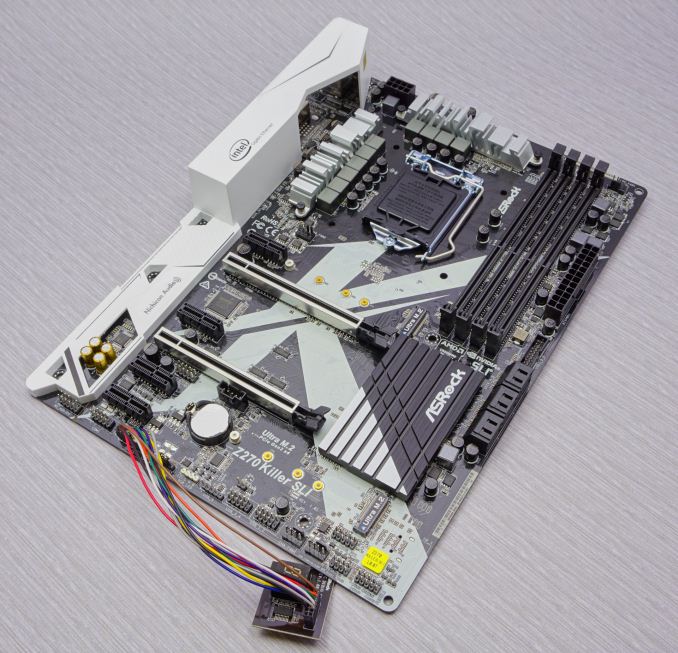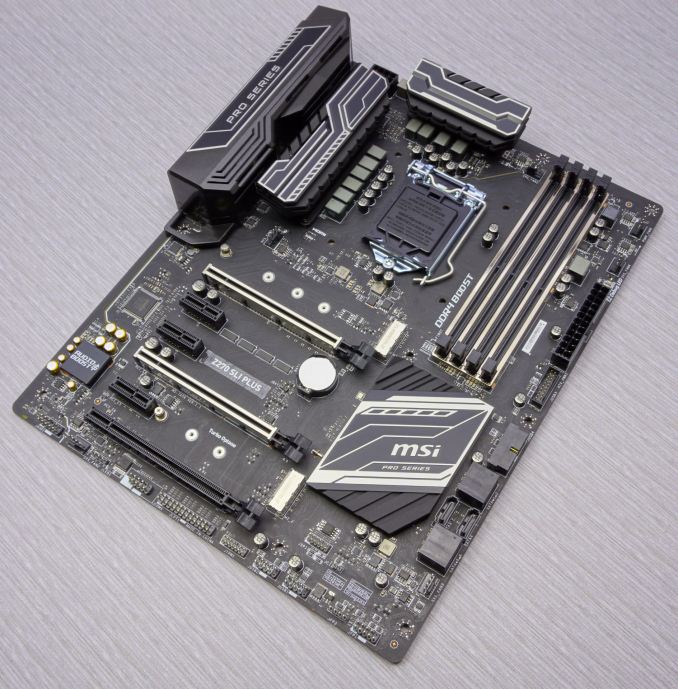Kaby Lake Motherboards at $140: MSI Z270 SLI Plus vs. ASRock Z270 Killer SLI
by E. Fylladitakis on May 1, 2017 10:30 AM EST- Posted in
- Motherboards
- Intel
- MSI
- ASRock
- SLI
- Kaby Lake
- Z270
- Z270 SLI PLUS
- Z270 Killer SLI
Conclusion
Both of the MSI Z270 SLI Plus and the ASRock Z270 Killer SLI are targeted towards the same market segment, that of entry and mainstream gamers. The approach that each manufacturer takes, however, is slightly different and each motherboard will appeal to a different group of users.
ASRock is placing a lot of effort on aesthetics, with the Z270 Killer SLI featuring onboard RGB lighting plus a header for RGB LED strips. The motherboard itself also sports a unique paint job, with a white huge “K” breaking the simplicity of the glossy black paint. MSI’s Z270 SLI Plus also has a header for RGB LED strips but the onboard LEDs are white, while the entire motherboard is black, with silver accents provided by the steel slot brace supports and on the heatsinks. The MSI Z270 SLI Plus is by no means bad looking but it definitely is not as flashy as the ASRock Z270 Killer SLI.
In terms of CPU and gaming performance, both of these motherboards are virtually equal. Any and all performance differences are minuscule and well within the small statistical error margin. When it comes to overall system performance however, the MSI Z270 SLI Plus is significantly superior on the controller front, with the much better audio codec delivering a better sound experience and the presence of the USB 3.1 controller significantly boosting file transfer times. ASRock does have an advantage in both the power consumption (due to the better quality of the power delivery) and the presence of the optical SPDIF out port, but users who do are indifferent about those are much more likely to be enticed by the better controllers found on MSI’s offering. The ASRock Z270 Killer SLI also has an onboard Thunderbolt header that could entice a small portion of users. On the other hand, the MSI Z270 SLI Plus can support a 22110 M.2 device and it has a third PCI-E ×16 slot, allowing more flexible storage device options. Other small differences include MSI using steel braces on the dual-side lock DIMM slots and a 10-phase VRM in comparison to the simple single-side DIMM slots and the 8-phase VRM of the ASRock Z270 Killer SLI, which arguably increases the overall quality of the design a little.
As far as similarities go, both motherboards have two PCI-E 3.0 ×4 M.2 slots and using SATA M.2 devices in these slots will always disable a SATA port on either board. The onboard network controller of both boards is the popular Intel I219-V and both have a COM port header. The MSI Z270 SLI Plus also has a parallel port header, quite possibly because the designer thought that some gamer might want to use a really old joystick for some retro gaming.
Considering that the CPU and gaming performance of both motherboards is the same, as is their current retail price tag, the MSI Z270 SLI Plus initially appears to be a reasonable choice. It has a much better audio codec, an USB 3.1 controller, can support 22110 M.2 devices, and has an extra PCI-E ×16 slot. However, it lacks Thunderbolt support and optical SPDIF out port, features that can instantly drive some users towards the ASRock Z270 Killer SLI. There is also the matter of aesthetics and beauty is in the eye of the beholder, so the RGB lighting and unique paint job of the ASRock Z270 Killer SLI can actually be more important to some users than USB 3.1 support and top-grade audio. Neither motherboard will disappoint with its performance but, considering their features, the MSI Z270 SLI Plus appears to have a better market potential at the moment of this review.












20 Comments
View All Comments
A5 - Monday, May 1, 2017 - link
Nice article, more mainstream reviews are always appreciated.austinsguitar - Monday, May 1, 2017 - link
people need to realize that z270 and intel are still a great buy for regular users. its not a bad investment. i just prey that 6core comes in time to consumers.ddriver - Monday, May 1, 2017 - link
Aside from the fact it is highly unlikely it will accept more than a single generation of processors.Cygni - Monday, May 1, 2017 - link
Seems pretty likely that Coffee Lake is intended to be compatible with Z270.ddriver - Monday, May 1, 2017 - link
That would be a new one for intel ;) If that happens, I guess "competition". For years now, intel has been artificially limiting chipset compatibility to squeeze extra chipset sales by obstructing upgrades.ronnie.d.davidson@outlook.com - Sunday, May 7, 2017 - link
Thats not what I've been reading....New Intel Coffee Lake 6 Core CPU's will need the 300 Series Chipset which means....New Motherboard !ronnie.d.davidson@outlook.com - Sunday, May 7, 2017 - link
The Inter Coffee Lake 6 Core CPU's will need the 300 Series Chipsets which means...New Motherboard !fanofanand - Monday, May 1, 2017 - link
Totally agree, more reviews of the volume pieces would benefit far more readers. I won't be buying either of these but at least now I know why.Arbie - Monday, May 1, 2017 - link
It's incredible that they can market something so complex, with so many precision parts, materials, and process steps - not to mention all the ICs - for a delivered price of $140! These are the benefits to us of mass production and sadly low foreign wages. Given that I'd use such a mobo heavily for hours every day, for years, I'd willingly pay more if I knew the workers got more.rocky12345 - Monday, May 1, 2017 - link
Nice write up Thank You. I just looked the MSI board up at Memory Express in Canada it goes for $209.99 CAD which sounds about right after exchange rate.